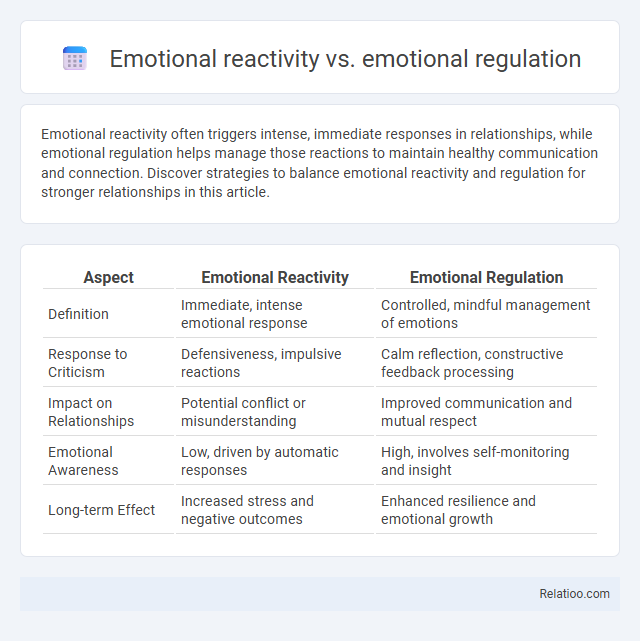Emotional reactivity often triggers intense, immediate responses in relationships, while emotional regulation helps manage those reactions to maintain healthy communication and connection. Discover strategies to balance emotional reactivity and regulation for stronger relationships in this article.
Table of Comparison
| Aspect | Emotional Reactivity | Emotional Regulation |
|---|---|---|
| Definition | Immediate, intense emotional response | Controlled, mindful management of emotions |
| Response to Criticism | Defensiveness, impulsive reactions | Calm reflection, constructive feedback processing |
| Impact on Relationships | Potential conflict or misunderstanding | Improved communication and mutual respect |
| Emotional Awareness | Low, driven by automatic responses | High, involves self-monitoring and insight |
| Long-term Effect | Increased stress and negative outcomes | Enhanced resilience and emotional growth |
Understanding Emotional Reactivity
Emotional reactivity refers to the intensity and speed at which individuals respond to emotional stimuli, often triggered by stress or unexpected events. It is distinct from emotional regulation, which involves managing and modulating these responses to maintain emotional stability. Understanding emotional reactivity helps identify patterns in how people perceive and react to emotional challenges, providing insights into mental health and adaptive coping strategies.
What Is Emotional Regulation?
Emotional regulation refers to the ability to manage and modify emotional responses in a way that is appropriate for the situation, helping individuals maintain control over their feelings and reactions. It involves processes such as recognizing emotions, employing coping strategies, and adjusting intensity or duration of emotional experiences. Effective emotional regulation supports mental health by reducing impulsive reactions and enhancing resilience in stressful situations.
Key Differences Between Emotional Reactivity and Regulation
Emotional reactivity refers to the intensity and speed of your immediate emotional responses to stimuli, while emotional regulation involves managing and modifying those emotional reactions to achieve adaptive outcomes. The key difference lies in reactivity being an automatic, often impulsive response, whereas regulation requires conscious effort, strategies, and self-control to influence emotions constructively. Effective emotional regulation enhances resilience and decision-making by reducing the potential negative impact of heightened emotional reactivity on your behavior.
Signs of High Emotional Reactivity
Signs of high emotional reactivity include intense and immediate responses to stimuli, frequent mood swings, and difficulty calming down after emotional arousal. Individuals with high emotional reactivity often experience overwhelming feelings that can interfere with decision-making and social interactions. Unlike emotional regulation, which involves managing and modulating these responses, high reactivity reflects a heightened sensitivity to emotional triggers.
The Science Behind Emotional Regulation
Emotional regulation involves the cognitive and neural mechanisms that modulate emotional responses, engaging brain regions such as the prefrontal cortex and amygdala to balance emotional reactivity. Emotional reactivity refers to the intensity and speed of emotional responses triggered by stimuli, often linked to heightened amygdala activation. Scientific studies highlight that effective emotional regulation reduces excessive reactivity, promoting psychological resilience and adaptive behavior through top-down control processes.
Causes of Emotional Reactivity
Emotional reactivity primarily stems from genetic predispositions, early childhood experiences, and heightened sensitivity to environmental stimuli, influencing how intensely you respond to emotions. Unlike emotional regulation, which involves consciously managing and modifying emotional responses, emotional reactivity occurs automatically and often subconsciously due to amygdala hyperactivity and impaired prefrontal cortex control. Understanding the neurobiological and psychological causes behind emotional reactivity is crucial for developing effective strategies to improve your emotional regulation skills.
Benefits of Effective Emotional Regulation
Effective emotional regulation enhances mental well-being by enabling individuals to manage intense emotions, reducing stress and anxiety. It fosters resilience and improves interpersonal relationships through better communication and empathy. Unlike emotional reactivity, which often leads to impulsive responses, emotional regulation supports thoughtful decision-making and long-term emotional stability.
Common Challenges in Managing Emotions
Emotional reactivity involves immediate, intense responses to stimuli, often making it difficult to pause or reflect before reacting, which challenges effective emotional management. Emotional regulation requires deliberate strategies like cognitive reappraisal or mindfulness to modulate these initial reactions and maintain psychological balance. Common challenges include overcoming automatic impulsive responses, managing stress-induced emotional overload, and developing consistent regulation techniques to prevent emotional dysregulation and its impact on mental health.
Strategies to Shift from Reactivity to Regulation
Emotional reactivity involves automatic, intense responses to stimuli, whereas emotional regulation refers to consciously managing and modulating these reactions for adaptive outcomes. Effective strategies to shift from reactivity to regulation include mindfulness practices that increase awareness of emotional triggers, cognitive reframing to alter negative thought patterns, and deep-breathing techniques that activate the parasympathetic nervous system. Consistent application of these methods enhances prefrontal cortex function, reducing amygdala-driven impulsive responses and promoting emotional resilience.
Building Emotional Intelligence for Better Regulation
Emotional reactivity involves immediate, automatic responses to stimuli, while emotional regulation encompasses the strategies and processes used to manage and modify these emotions effectively. Building emotional intelligence enhances your ability to recognize and understand emotional triggers, enabling better regulation and reducing impulsive reactions. Developing strong emotional intelligence skills fosters resilience, improves decision-making, and promotes healthier interpersonal relationships.

Infographic: Emotional reactivity vs Emotional regulation
 relatioo.com
relatioo.com